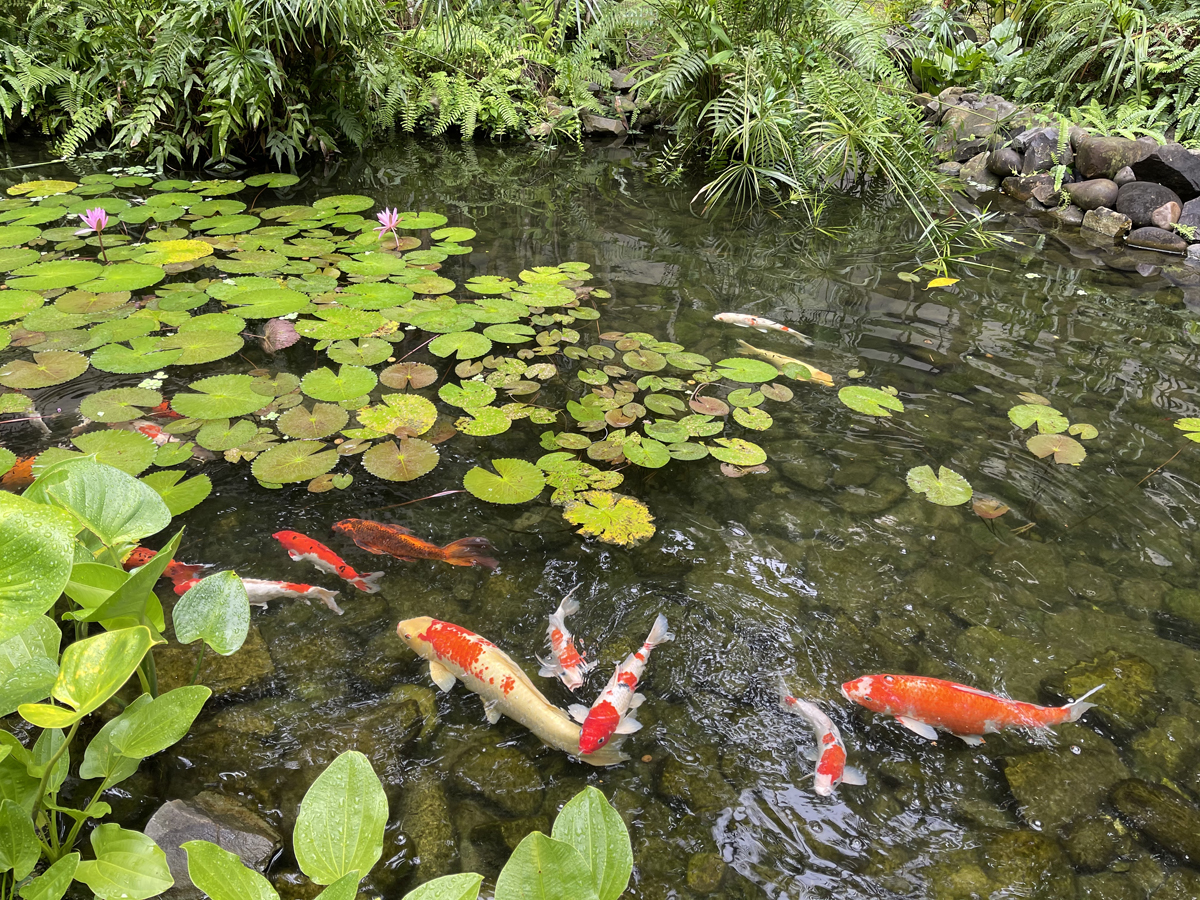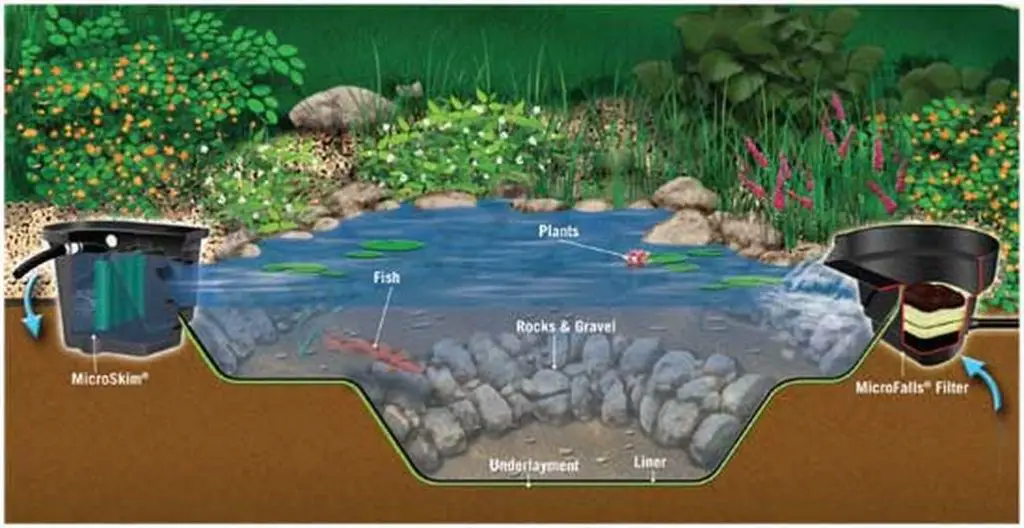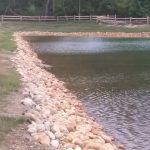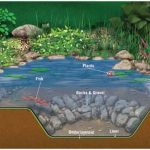A koi pond needs to be at least 3 feet deep for the successful growth and health of koi fish. Koi ponds provide a tranquil and beautiful addition to any garden or backyard.
These colorful and graceful fish are a delight to watch as they glide through the water. However, in order to create the ideal environment for koi fish, it is important to consider the depth of the pond. The depth of a koi pond plays a crucial role in maintaining the proper temperature, providing protection from predators, and promoting the overall well-being of the fish.
In general, a koi pond should be at least 3 feet deep. This depth ensures that the water remains stable and allows the fish to comfortably swim and explore their environment. Additionally, a deeper pond provides better insulation against extreme temperatures and offers a safe haven from predators.
Importance Of Pond Depth
Koi ponds are not just a beautiful addition to a garden, but they also provide a habitat for the fish that live within them. Creating an environment that supports the health and natural behavior of koi fish requires careful consideration of the depth of the pond. The importance of pond depth cannot be overstated, as it directly impacts the well-being of the fish and their ability to exhibit their natural behaviors.
Ensuring Fish Health
The right pond depth is crucial for ensuring the health and well-being of koi fish. Deeper ponds provide more stable water temperatures, especially during extreme weather conditions, which is essential for the health of the fish. Moreover, deeper ponds offer a larger volume of water, ensuring better dilution of fish waste and maintaining water quality. This creates a healthier environment for the fish to thrive in.
Promoting Natural Behavior
The depth of the pond influences the natural behavior of koi fish. Deeper ponds mimic their natural habitat and provide ample space for the fish to swim and explore. This enables the fish to exhibit their natural behaviors, including foraging, mating, and seeking shelter. Furthermore, deeper ponds allow the fish to dive and swim freely, promoting exercise and overall well-being.
Factors Influencing Pond Depth
Koi Species
The depth of a koi pond is significantly influenced by the type of koi species you plan to keep. Different koi varieties have varying preferences in water depth. For example, longfin or butterfly koi thrive in shallower water, while traditional koi species generally prefer deeper environments to exhibit their natural behaviors.
Climate Considerations
Climate plays a crucial role in determining the optimal depth of a koi pond. In regions with extreme temperatures, such as areas experiencing harsh winters, a deeper pond can provide greater thermal stability, ensuring the koi’s survival during cold spells. On the other hand, in warmer climates, a shallower pond may be sufficient, as it promotes better oxygen circulation and prevents overheating.
Pond Size And Volume
The size and volume of the pond directly impact its depth requirements. A larger pond typically allows for more flexibility in depth, as the water volume can support the necessary oxygen levels and temperature regulation. Additionally, a deeper pond with ample volume provides a more stable ecosystem for koi, reducing the risk of water quality issues.
Recommended Depths For Koi Ponds
Discover the recommended depths for koi ponds to ensure the optimal environment for these beautiful fish. Understanding the best depths for your koi pond is essential for their health and well-being.
Minimum Depth Standards
Minimum depth for a koi pond should be at least three feet to provide enough space for the fish to swim and grow. This depth helps koi escape predators and reduces temperature fluctuations.
General Depth Guidelines
General depth of a koi pond ranges from four to six feet for optimal conditions. Deeper ponds offer more stability in temperature and water quality, which are crucial for koi’s health and growth.
Deep Vs. Shallow Ponds
- Deep ponds: offer better insulation, stable temperatures, and ample swimming space for koi.
- Shallow ponds: are prone to temperature fluctuations and limited space for koi movement.

Credit: thebackyardpond.com
Impacts Of Incorrect Pond Depth
A koi pond needs to be deep enough to maintain a stable environment for the fish. Incorrect pond depth can have negative impacts on their health and overall well-being. It is essential to ensure the proper depth to avoid any potential issues.
Adequate pond depth is crucial for the health and well-being of your koi fish. If the pond is too shallow, it can have serious consequences on the growth, temperature regulation, and behavior of your beloved koi. In this section, we will explore the specific impacts that incorrect pond depth can have on your fish.
Stunted Growth
Insufficient pond depth can lead to stunted growth in koi fish. When a pond is too shallow, it limits the swim space available for the fish to move and exercise. Koi require room to swim freely in order to develop strong muscles and promote healthy growth. Without proper depth, their growth can become stunted, resulting in smaller and weaker koi.
Temperature Fluctuations
Inadequate pond depth can also lead to significant temperature fluctuations. Shallow ponds are more susceptible to changes in ambient temperatures, which can cause the water in the pond to heat up or cool down rapidly. These temperature fluctuations can greatly stress the koi and disrupt their metabolic processes. For example, when the water becomes too hot, it can lead to decreased oxygen levels, making it difficult for the koi to breathe and thrive. Conversely, sudden drops in temperature can weaken their immune system, making them more susceptible to diseases.
Aggression And Stress
Incorrect pond depth can incite aggression and stress among koi fish. In shallow ponds, the limited swimming space can create a highly competitive environment for the fish. With less room to establish hierarchies and territories, conflicts can arise, leading to aggressive behavior such as fin nipping and chasing. Additionally, the stress caused by overcrowding in a shallow pond can compromise the koi’s immune system, making them more vulnerable to diseases and infections.
Construction And Maintenance Tips
For a healthy koi pond, aim for a depth of at least three to four feet. This depth ensures enough space for the fish to thrive and survive winter conditions. Additionally, a deeper pond helps maintain stable water temperature and quality, promoting koi health and longevity.
Excavation Tips
- A deeper pond of at least 3 feet is recommended for koi to thrive.
- Prioritize a gradual slope to ensure proper circulation and oxygenation.
Filter And Aeration Systems
Invest in high-quality filtration and aeration systems to keep water clean and oxygenated.
Regular Monitoring
- Check water quality frequently, especially levels of ammonia and nitrites.
- Inspect filter systems regularly to ensure smooth functioning.

Credit: cartersgarden.wordpress.com
Seasonal Considerations
When it comes to maintaining a koi pond, it’s important to consider the seasonal variations that can affect the health and well-being of your fish. By understanding the specific needs of your koi during different times of the year, you can create a suitable environment that promotes their growth and longevity. Two key seasonal considerations are winter preparations and summer heat management.
Winter Preparations
The harsh winter months can pose challenges for koi pond owners. Freezing temperatures and ice cover can lead to oxygen depletion and higher toxin levels in the water. To ensure the well-being of your fish during this time, it’s crucial to make adequate preparations.
Determining the ideal depth for your koi pond is essential when preparing for winter. A depth of at least 3 feet is recommended, as it provides a stable water temperature that is less prone to extreme fluctuations. Deeper ponds also offer a layer of insulation, protecting the fish from freezing conditions.
Additionally, consider the use of a pond heater or de-icer to prevent the pond from completely freezing over. These devices can help maintain a small opening in the ice, allowing vital oxygen exchange to occur. Regular monitoring of water quality and making adjustments as needed will also ensure a healthier environment for your fish during the winter season.
Summer Heat Management
The summer heat can be just as challenging for koi as the winter cold. High temperatures can lead to decreased oxygen levels, increased algae growth, and even heat stress or death for your fish. Implementing proper heat management strategies is crucial to keep your koi pond thriving during the hot months.
One important factor to consider is shading. Providing sufficient shade over the pond helps reduce water temperature and minimizes the growth of algae. This can be achieved by using aquatic plants, floating shade covers, or strategically placed umbrellas or pergolas.
In addition to shading, ensure a high level of aeration and circulation in the pond. Installing a pond aerator or fountain helps to increase oxygen levels and maintain water quality. Regularly testing the water parameters and performing water changes when necessary can also prevent the buildup of harmful toxins.
Finally, avoid overfeeding your koi during the summer. Excess food can not only lead to poor water quality but also increases the metabolism of the fish, making them more susceptible to heat stress. Feed your koi only what they can consume within a few minutes, and choose a high-quality diet that meets their nutritional requirements.
By taking these seasonal considerations into account, you can provide a stable and healthy environment for your koi throughout the year. Remember, a well-maintained koi pond not only benefits the fish but also enhances the overall beauty and enjoyment of your outdoor space.
Expert Insights And Interviews
For a definitive understanding of how deep a koi pond needs to be, we have sought insights from experienced koi enthusiasts and professional pond builders. Their expertise provides valuable perspectives on the ideal depth for a koi pond, ensuring the health, happiness, and longevity of the beloved aquatic pets.
Experienced Koi Enthusiasts
Seasoned koi enthusiasts stress the importance of providing sufficient depth in koi ponds. Breeding and exhibiting koi for numerous years, they advocate for maintaining a minimum depth of at least 4 feet. This depth enables the koi to thrive in a natural-like environment and offers protection from predators. As social creatures, having ample space to swim and explore is essential for their well-being, as confirmed by experienced koi enthusiasts.
Professional Pond Builders
Professional pond builders, with extensive experience in designing and constructing koi ponds, emphasize the critical role of depth. They emphasize the necessity of creating depth variations, with special attention to the installation of shelves and deeper areas. These variations replicate the natural habitats of koi and facilitate opportunities for temperature regulation and exploration. This insight from professional pond builders underscores the significance of depth in ensuring a hospitable environment for koi.
Credit: aquanooga.com
Designing A Koi Pond For Long-term Success
Achieving long-term success with a koi pond involves careful planning and thoughtful design. One crucial aspect to consider is the depth of the pond, as it directly impacts the health and well-being of the koi. Designing a koi pond for long-term success requires careful attention to both aesthetics and functionality, as well as the potential for future expansion. By understanding the ideal depth, you can create a thriving environment for your koi while laying the foundation for potential growth. Let’s explore the key considerations in designing a koi pond that promotes longevity and success.
Balancing Aesthetics And Functionality
When designing a koi pond, it’s essential to strike a balance between aesthetics and functionality. While it’s natural to prioritize the visual appeal of the pond, it’s equally important to ensure that the depth meets the specific needs of koi. Ensuring adequate depth not only provides the necessary space for koi to thrive but also contributes to the overall health of the pond ecosystem. By carefully balancing aesthetics with functionality, you can create a visually stunning pond that also supports the well-being of your koi.
Future Expansion Plans
Considering future expansion plans when designing a koi pond is crucial for long-term success. Anticipating the potential need for expansion allows you to plan for a pond depth that accommodates future growth. This proactive approach can prevent the need for extensive redesign or reconstruction down the line. By factoring in future expansion from the initial design stages, you can create a koi pond that is primed for sustainable growth and adaptability as your koi population and pond needs evolve.
Conclusion
Incorporating the right depth for your koi pond is crucial. Remember, balance in design means providing adequate space for your koi to thrive. By understanding the ideal depth requirements, you can create a harmonious environment for these beautiful fish in your backyard oasis.
Start digging wisely!





